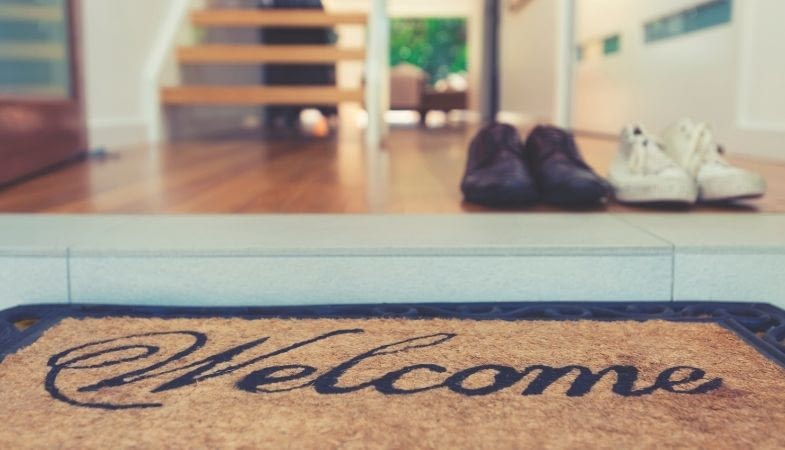
What happens at a house showing? This important question has historically been eclipsed by others like, “How much should we list for?” and “How long will it take to sell?” However, COVID-19 has home many sellers considering showings from a different perspective, with extra attention paid to safety, convenience and current best-practices (think technology). Here’s what home sellers can expect when they’re showing their home, and how they can maximize this opportunity to yield higher offers and quicker sale.
Showings versus Open Houses
Showings and open houses are different. As the name suggests, an “open house” is when the seller opens their door to anyone who wants to pop in for a closer look. This method of showing a listing was extremely popular until the pandemic hit in early 2020. Homebuyers would scour property listings all week, map out the open-houses online and plan their weekend route. And before technology and the Internet changed literally everything, families would pile into their cars on Saturday and Sunday afternoons, driving around their preferred neighbourhoods in search of the “sandwich” signs lining sidewalks, touting this typically two-hour event: Open House: 2-4PM. Come on in!
Times may have changed, but the process behind appealing to homebuyers hasn’t changed a ton from what it looked like 30 years ago. However, if you have never sold a home, you’re likely wondering what happens at a house showing.
More recently, COVID-19 prompted a mandatory shift in how homes are shown – and seen. Government-mandated health and safety measures put pause to the “open-door” policy, for obvious reasons, in favour of virtual home tours as a no-contact way of showing listings. Once buyers found a listing that met their criteria for a new home, they would venture out, masked and in minimal numbers, to view the home in person. Some homebuyers even took the transaction completely virtual, with the showing, offer, negotiations and final paperwork all done remotely.
Today, the convenience of the virtual sale continues to be a trend that’s unlikely to wane, thanks to technology and sheer convenience. However, with widespread vaccination efforts in place and infection numbers trend downward, many Canadians are eagerly awaiting a return to a post-pandemic life. For many homebuyers and sellers, this includes in-person showings.
What happens at a house showing?
After everything we’ve lived and learned over the last year and half, some things have changed in the show-showing process. Here’s a quick refresher of what home sellers can expect when showing their home.
Schedule the showing.
When homebuyers find a listing they might like to purchase, most will wand to view it in person before making an offer. They’ll be eager to see it as soon as possible, which is particularly true in a hot seller’s market when timing is everything, and even a seemingly short delay can cost them their opportunity to buy.
During the selling period, be available to communicate with your real estate agent at a moment’s notice to ensure the timely scheduling of showings. As your agent to give you a couple of hours’ notice, but it’s in your best interest to be as flexible as possible. It’s always a good idea to ensure your agent is aware of any factors that could impact the timing of showings, such as the need for a quick clean-up if you’re still living in the home, or time required to vacate the home of pets and people (more on that, below!).
How will you know when there’s a showing?
Discuss the best form of communication with your real estate agent ahead of time. How would you like to be contacted? Choose a mode of communication that you’ll have easy access to and will check often. This can include, but is not limited to, email, a phone call, text message, calendar invite or a scheduling app, if your agent uses one. As mentioned, your agent can give you some advance notice, if you need it.
Who shows the home?
Your listing agent will be present during the property showing, and prospective buyers will be accompanied by their agent as well. If a buyer isn’t represented by an agent, they’d typically contact the listing agent directly, who would walk them through the property.
While it’s entirely at the seller’s discretion, most homeowners will vacate the property during showings. The showing is usually booked for one hour. Go for a walk, go for a drive, or go run some errands. Just go! Having homeowners present during showings can turn some homebuyers off, making it difficult for them to picture themselves living in the home, or creating an awkward situation when discussing their honest feelings about the place.
If you’re expecting many showings in a hot market or a popular area, it might be a good time to book a holiday away from home. This reduces the inconvenience to you, while ensuring the home stays in “showing condition” without constant clean-up on your part.
What happens during the showing?
The homebuyers will have access to your property during their pre-determined time – typically one hour. They are expected to arrive, view and leave within that time. Their agent will walk them through the home, ensuring they remove their shoes and follow protocols, and answering their questions. If the agent isn’t sure of the answer, they will find out by way of the listing agent.
During the showing, you can expect the buyers to look in cabinets, cupboards and closets, from top to bottom. Furniture drawers and the like are off limits, since you’ll be taking those with you when you move, but anything that is built-in will be assessed for storage capacity, quality and condition. Don’t forget about the basement, attic, garage, shed and utility areas!
Speaking of which, buyers may also test the utilities by running the water taps, flushing toilets, checking light switches and testing electrical outlets. Some buyers may even use this opportunity to do a home inspection (this should be communicated to the listing agent and seller beforehand), so if they choose to make an offer, they can do so without having this condition in place.
During the pandemic, some sellers are choosing to leave closet doors open and lights on, to help minimize physical contact.
RELATED READING: House showing tips for buyers viewing homes virtually
After the showing
Now that you know exactly what happens at a house showing, what next? When the showing is complete, the buyers’ agent is responsible for ensuring the property is left in the same condition in which it was found, and that the door is locked.
Then, depending on market conditions, it can be a waiting game. If the buyer has any follow-up questions or would like to make an offer, communication generally happens between the buying and listing agents. If the buyers are choosing to pass on the property, some listing agents may even reach out to the buying agent, to get feedback on the listing – price, the condition or features of the home, the neighbourhood, or anything else that has swayed the buyers away. If the home isn’t selling, this feedback can prove valuable when revisiting the listing strategy. Of course, there are clear signs a house showing went well, generally coming in the form of speedy offer at or over asking price!
If you want more details about what happens at a house showing, or if you have specific questions, your real estate agent will be happy to answer them.
Original Post Credit: PR & Content Manager, RE/Max Canada, Lydia McNutt
.


